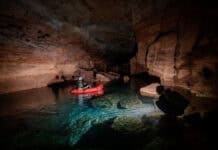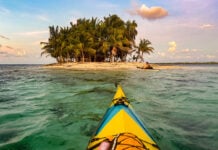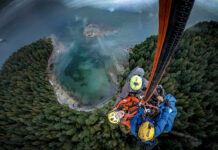Last summer, our small group of paddlers set off from the northern tip of Vancouver Island into British Columbia’s Great Bear Rainforest. We were in search of the fish farms spreading out across the area, which had become a source of political debate between the provincial government and the Indigenous communities.
The farms were not hard to find. The eyesores dotted the area closest to Vancouver Island, right up to the border of the famous Broughton Archipelago Provincial Park. One moment we saw humpback whales breaching around us, surrounded by huge forested islands, and the next we turned a corner to see a massive chain-link fence in the middle of the ocean. These fenced-in perimeters host thousands of Atlantic salmon, swimming in circles, in what is considered by many to be unsustainable fish farms.
We paddled deep into the Great Bear Rainforest to see how far the farms penetrated. During our search, we circumnavigated Gilford Island and as we did, the farms ceased for a time. The break from the farms was a feeling of freedom; our eyes were free to wander the landscape with what we thought would be uninterrupted beauty. Unfortunately, we were wrong.
Human Impact On The Great Bear Rainforest
The area around Gilford Island, like many areas of the Great Bear Rainforest, has tracts of ongoing logging. Roads dotted the landscape, almost all of the forest was second or third growth with little old growth remaining. Most nights smoke from forest fires roaring across the province turned the sun into a blazing red ball in the sky.
Do not misunderstand me. The area is beautiful—dolphins jumped next to our boats, we saw orcas breeding, witnessed bears feeding on beaches and eagles diving for fish. But it was difficult not to feel regret when thinking about how much more beautiful this area must have been before the human impact.
Most mornings, I crawled out of my tent already dressed in my drysuit while the morning rain pelted my face. My companions reminded me, “If you are going to paddle in a rainforest, you should expect regular rains.” But on one morning, we woke up to the sun beaming down on us. A bear was digging for food down the beach, and it being warm and bright, and us excited to see our first bear, we were slow to act.
This backdrop is what I had imagined the whole of the Great Bear Rainforest to be—green, lush, and deceivingly inviting.
As some of our team was packing our stuff sacks into our Boreal Design kayaks, we realized it was already early afternoon. We had a short crossing that day and arrived at camp as the sun was setting after a 20-kilometer paddle. This was when I snapped this shot. The forest behind the kayak was the perfect backdrop, with the sun just over the cusp of Gilford Island, causing a small amount of flare on the lens.
This backdrop is what I had imagined the whole of the Great Bear Rainforest to be—green, lush, and deceivingly inviting. Vast areas of the Great Bear Rainforest were out-of-this-world beautiful, but if I just turned my head slightly, too often I saw the devastation in the mountains and on the ocean. For me, this photo represents what the area could be in entirety, rather than just when your eyes are facing the correct direction.








